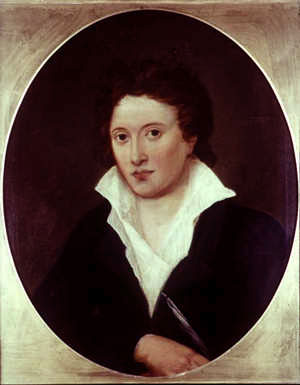On this date Percy Bysshe Shelley died (1792-1822).
Frye in conversation with David Cayley:
Literature doesn’t argue. That’s the principle of Shelley’s Defence of Poetry — that literature doesn’t argue. As Yeats says, “You can refute Hegel but not the Song of Sixpence.” The whole argumentative side is something that critics, without examining the matter, think must be true of criticism but not of literature. But to me criticism is really the expression of the awareness of language. And what I try to do in my writing is express awareness of language, particularly of literary language and what it’s trying to do. (CW 24, 953-4)
Shelley’s “A Defense of Poetry” here.


From Frye’s THE CRITICAL PATH:
Shelley’s defence, though it looks as though it were ignoring Peacock’s thesis, actually provides a close and searching answer to it. The main point of the answer consists in the shifting of the emphasis from the historically to the psychologically primitive. Shelley begins by neatly inverting the hierarchy of values assumed in Sidney. Sidney is concerned to show that poetry is a genuine instrument of education, along with religion, morality, and law, but their claim to be educational is prior and unquestioned. Shelley puts all the discursive disciplines into an inferior group of “analytic” operations of reason. They are aggressive; they think of ideas as weapons; they seek the irrefutable argument, which keeps eluding them because all arguments are theses, and theses are half truths implying their own opposites. Some of the discursive writers are defenders of the social status quo: not only do they fail to defend it, but they exasperate and embitter a society in which the rich get richer and the poor poorer. There are also liberal and radical discursive writers: they are on Shelley’s side and he approves of them, but being only the other half of the argumentative disciplines, the amount of good they can do is limited. The works of imagination, by contrast, cannot be refuted: poetry is the dialectic of love, which treats everything it encounters as another form of itself, and never attacks, only includes. Thus there appears in Shelley, as in his predecessors, the conception of a model world above the existing world. This model world for him, however, is associated not with the Christian unfallen world, nor even with the Classical Golden Age, in spite of some allusions to the latter in the Defence, but rather with the higher reason, Vernunft as distinct from Verstand, which so many Romantics identified with the imagination.
This argument assumes, not only that the language of poetry is mythical, but that poetry, in its totality, is in fact society’s real myth of concern, and that the poet is still the teacher of that myth. He may be an “unacknowledged legislator,” but he is still the lawgiver of civilization, as in ancient times, even if nobody realizes it. There is a reality out there, a reality which is given and has in itself no moral significance, which the lower understanding studies, and there is the reality which does not exist to begin with, but is brought into being through a certain kind of creative activity. The metaphor of creation, if it is a metaphor, is not new with the Romantics, and most of the better Elizabethan critics understood what is meant by “creative” very well. But in Sidney’s day it was accepted that the models of creation were established by God: for Shelley, man makes his own civilization, and at the centre of man’s creation are the poets, whose work provides the models of human society. The myths of poetry embody and express man’s creation of his own culture, rather than his reception of it from a divine source.
Thanks for this comment which, for me, is very timely and very helpful.
Among some friends, I have a hard time explaining myself on the relationship of Frye (poetry/social vision) and Lonergan (philosophy/economics). Apart from the fact that both these men are canadians and both published their pivotal work in 1957: ANATOMY OF CRITICISM and INSIGHT, it is very difficult to articulate adequately their real and radical relationship and common vision.
Clearly, divisions are now apparent among Lonergan disciples: between those who grew up in the school of hermeneutics [Loneran’s METHOD IN THEOLOGY (1972) and those who studied in the school of science and analysis [Lonergan’s INSIGHT 1957).
Similar divisions are emerging among Frye disciples: between those who grew up inside FEARFUL SYMMETRY [VISIONARY] and those who are more at home in ANATOMY OF CRITICISM [ANALYTIC]. And bridging this gap will take time and much ink. On this topic, the most helpful article, I have come across, is Jean O’Grady’s recent “Re-Valuing Value” (2009), available on this blog. Dr. O’ Grady’s helpful distinction and challenge is in the hope for ongoing collaboration, and it is well expressed in her final sentence: “To progress from [Frye] dispassionate anatomist to fiery John the Baptist is indeed to take new directions from old.”
Closing the gap between genuine social action (Frye) and analytic economics (Lonergan) demands our committed concern, if we are to find a genuine solution to the problems presented to us by multinational corporations. Multinational corporations are indeed our central and current problem. A recent book by economist, Eileen de Neeve, who is aware of both Frye and Lonergan, is entitled DECODING THE ECONOMY, Thomas More Institute Papers /08, which I highly recommend to all serious readers of both Lonergan and Fye.